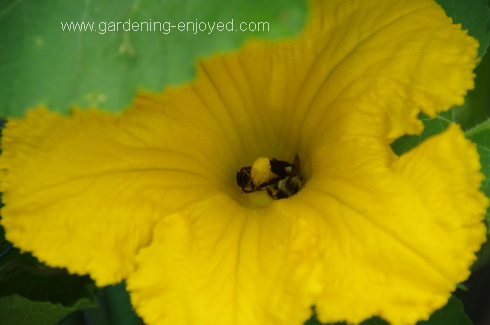| Back to Back Issues Page |
 |
|
Dallying In The Dirt, Issue #324 - The summer is filled with tomatoes, bugs, weeds, marigolds and ot August 07, 2018 |
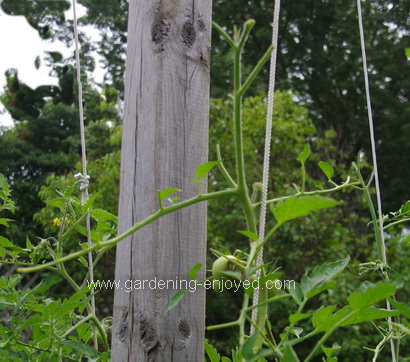 These green sticks do not make me happy. They weren’t there a couple of days ago but I immediately knew what to look for. This is the work of the Tomato Horn Worm. They are huge creatures, 7 - 10 cm long, that can mow down a Tomato plant with incredible speed. I found just three of them and there were four or five Tomato plants that looked like this. I check those plants almost daily to see if they need tying up or pruning or if they have managed to ripen any fruit. That kind of destruction can happen that quickly. I haven’t see Tomato Horn Worms for several years so it was quite surprising to see them show up this year. There is a small temptation to not kill them. They will fall off the plants and pupate in the soil for a while and then emerge as the spectacular Hawk or Hummingbird Moth. These wonderfully marked creatures, usually in several shades of brown and white can be as large as 20 cm. I have
seen them occasionally, not easy, as they tend to be nocturnal, and they are quite impressive creatures but you have to sacrifice a Tomato or two to have them in your garden.
These green sticks do not make me happy. They weren’t there a couple of days ago but I immediately knew what to look for. This is the work of the Tomato Horn Worm. They are huge creatures, 7 - 10 cm long, that can mow down a Tomato plant with incredible speed. I found just three of them and there were four or five Tomato plants that looked like this. I check those plants almost daily to see if they need tying up or pruning or if they have managed to ripen any fruit. That kind of destruction can happen that quickly. I haven’t see Tomato Horn Worms for several years so it was quite surprising to see them show up this year. There is a small temptation to not kill them. They will fall off the plants and pupate in the soil for a while and then emerge as the spectacular Hawk or Hummingbird Moth. These wonderfully marked creatures, usually in several shades of brown and white can be as large as 20 cm. I have
seen them occasionally, not easy, as they tend to be nocturnal, and they are quite impressive creatures but you have to sacrifice a Tomato or two to have them in your garden.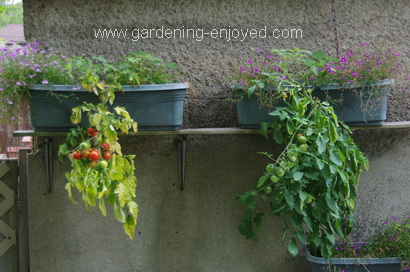 Now here is a curiosity that I can’t really figure out. These two planters have the same variety of Tomato, Tumbler, and they are, as you can see, side by side on the garage wall. They get watered and fertilized in exactly the same pattern and yet one is very chlorotic and struggling while its neighbour looks green and healthy. They both have produced some Tomatoes with the healthy one producing many more but the sick one has its fruit ripe already and the other has its fruit as green as its leaves????? While scratching my head over this the Assistant Gardener reminded me about why we have these planters on the garage wall. At least 10 years ago each of the ten planters were filled with a different commercial planting mix and the results over the season were the basis for a magazine article. It was quite amazing how different each of those planters responded over the summer. Is it possible that after all these years there is still enough difference in those planting
mixes to explain the different Tomato growth??? Now if I had only kept records!
Now here is a curiosity that I can’t really figure out. These two planters have the same variety of Tomato, Tumbler, and they are, as you can see, side by side on the garage wall. They get watered and fertilized in exactly the same pattern and yet one is very chlorotic and struggling while its neighbour looks green and healthy. They both have produced some Tomatoes with the healthy one producing many more but the sick one has its fruit ripe already and the other has its fruit as green as its leaves????? While scratching my head over this the Assistant Gardener reminded me about why we have these planters on the garage wall. At least 10 years ago each of the ten planters were filled with a different commercial planting mix and the results over the season were the basis for a magazine article. It was quite amazing how different each of those planters responded over the summer. Is it possible that after all these years there is still enough difference in those planting
mixes to explain the different Tomato growth??? Now if I had only kept records! 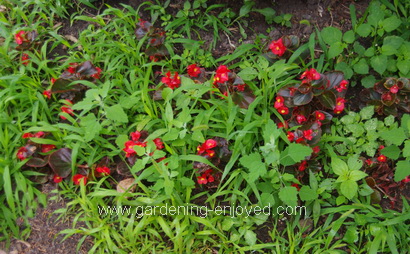 Now if this was a piece of art it could be entitled “Frustration.” These red Fibrous Begonias were planted in the shade of the Camperdown Elm sometime in the middle of June. The soil was worked up and clean at the time. You might notice that the lovely green grass, which I would call a weed, has thrived and overtaken the Begonias. Apparently that particular grass is not inhibited by the deep shade. I did supply some water and fertilizer to that little bed a few times in hopes that it would make the Begonias flourish. Now that I’ve recorded it for posterity I’ll have to find the half hour required to pull out the grass and hope that the Begonias will get ahead of the next batch of weeds. For there surely will be a next batch.
Now if this was a piece of art it could be entitled “Frustration.” These red Fibrous Begonias were planted in the shade of the Camperdown Elm sometime in the middle of June. The soil was worked up and clean at the time. You might notice that the lovely green grass, which I would call a weed, has thrived and overtaken the Begonias. Apparently that particular grass is not inhibited by the deep shade. I did supply some water and fertilizer to that little bed a few times in hopes that it would make the Begonias flourish. Now that I’ve recorded it for posterity I’ll have to find the half hour required to pull out the grass and hope that the Begonias will get ahead of the next batch of weeds. For there surely will be a next batch.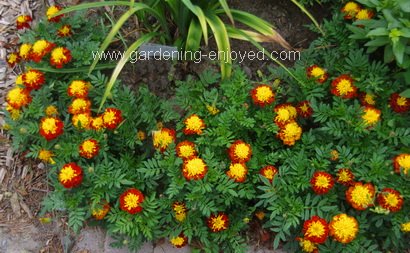 Let’s end with a success story. These are Marigold, Super Hero Spry. I grew them this year because they were an All America Selections winner and they have certainly proven why. I did pull the odd weed from between them but they have happily filled in a hot dry corner beside the driveway and provided a brilliant punch of colour for visitors pulling into that driveway. I’ve always been a fan of Marigolds. They are colourful, grow quickly and flower profusely all summer. Their nice large seeds make them easy for gardeners to start themselves and the seedlings grow quite happily under my lights for the few weeks that they need to be ready for the garden.
Let’s end with a success story. These are Marigold, Super Hero Spry. I grew them this year because they were an All America Selections winner and they have certainly proven why. I did pull the odd weed from between them but they have happily filled in a hot dry corner beside the driveway and provided a brilliant punch of colour for visitors pulling into that driveway. I’ve always been a fan of Marigolds. They are colourful, grow quickly and flower profusely all summer. Their nice large seeds make them easy for gardeners to start themselves and the seedlings grow quite happily under my lights for the few weeks that they need to be ready for the garden.Now it’s time to answer a few of my reader’s questions. To ask a question just “reply” to this ezine. Don’t forget to check the front page of the Website for frequent
short ideas for current gardening activities. Linda Asks? Can you propagate Clematis anytime, or is it best to do it in the spring. I would like to try it. Also which method works best, slicing, or planting in rooting hormone, or just plain putting it in water, which I have a good success rate with, with most plants? |
| Back to Back Issues Page |
